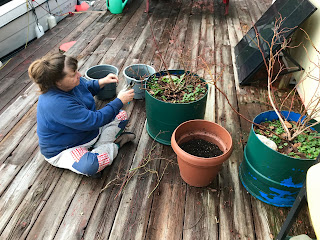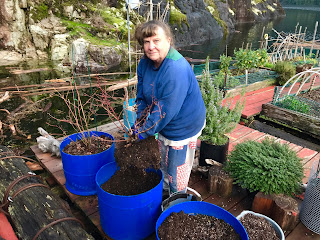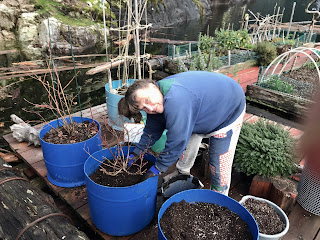 We have a seasonal visitor to our float cabin home on Powell Lake, a Great Blue Heron. Each fall he (or she maybe) returns to our protective log booms to fish. He stands motionless for a long time before leaping into action to catch a meal.
We have a seasonal visitor to our float cabin home on Powell Lake, a Great Blue Heron. Each fall he (or she maybe) returns to our protective log booms to fish. He stands motionless for a long time before leaping into action to catch a meal.
One morning I went out front and saw the Heron standing on the boom.
 |
| Look to the left of my floating garden for the Heron. |
I watched for a long time and even walked out to the corner of the float to take pictures without disturbing him.
 |
| Changing position. |
Great Blue Herons are a common sight at the marina in town and nest in nearby trees. The subspecies in our area is the
Pacific Great Blue Heron (
Ardea herodias fannini).
 |
| Flexing his wings. |
The Pacific Great Blue Heron has
Canadian Species at Risk Act (SARA) and
Canadian Committee on the Status of Endangered Wildlife in Canada (COSEWIC) special concern status. They are protected under the British Columbia Wildlife Act and the Canadian Migratory Birds Convention. When the City of Powell River was building a new community track, construction stopped due to the discovery of nests. We now have a lovely track away from the nesting site.
 |
| Framed by my floating garden. |
Pacific Great Blue Herons are found from Alaska to Washington State in coastal areas. They are a large bird standing over a metre in height. There are 4,000-5,000 adults in Canada.
 |
| Alert! |
Herons are identified by their blue and grey feathers and black stripe from the eyes backward. In flight, Herons look prehistoric,
matched by its piercing squawk.
Do you have Herons where you live? Are you as infatuated with them as I am? -- Margy
References:
Nature Canada, Pacific Great Blue Heron (online), The Cornell Lab of Ornithology
All About Birds, Great Blue Heron (online), and
Bird Watcher's Digest, Great Blue Heron (online).


 Wayne and I enjoy flying throughout the Pacific Northwest and beyond. Pilots and aviation enthusiasts will enjoy reading about some of our adventures in Flying the Pacific Northwest. Follow us to out-of-the-way spots in Western Washington and Oregon where
recreational pilots and their aircraft have the freedom to pursue adventure. It's available in print and e-book formats at Amazon and at most online booksellers. -- Margy
Wayne and I enjoy flying throughout the Pacific Northwest and beyond. Pilots and aviation enthusiasts will enjoy reading about some of our adventures in Flying the Pacific Northwest. Follow us to out-of-the-way spots in Western Washington and Oregon where
recreational pilots and their aircraft have the freedom to pursue adventure. It's available in print and e-book formats at Amazon and at most online booksellers. -- Margy











































